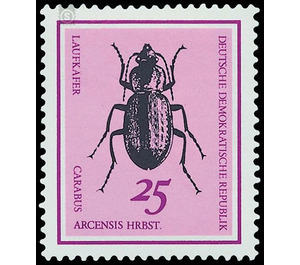Useful beetles - Germany / German Democratic Republic 1968 - 25 Pfennig
Theme: Animals
| Country | Germany / German Democratic Republic |
| Issue Date | 1968 |
| Face Value | 25.00 |
| Color | pink |
| Perforation | K 13 1/2: 13 |
| Printing Type | offset |
| Stamp Type | Postage stamp |
| Item Type | Stamp |
| Chronological Issue Number | 1156 |
| Chronological Chapter | GER-DDR |
| SID | 734309 |
| In 13 Wishlists | |
Useful Beetles The Ministry of Posts and Telecommunications of the German Democratic Republic issues six multicolored special postal stamps with pictures of useful beetles. Useful beetles The total number of beetles living in Central Europe is difficult to specify; Sure, there are a few hundred species. The difficulty arises not least from the fact that the concept of usefulness is difficult to define. There are many beetles that play an important role in the household of nature and are therefore indirectly useful. Many Silphidae (carrion beetles) eliminate animal carcasses, the dung beetles bring feces under the ground, Georyssidae and Heteroceridae eliminate organic sludge at pond and stream edges. These are very important and useful activities. This circumstance should not be forgotten when talking about beneficial beetles, because in general one thinks first of all of beetle species that play an important role in the natural control of pests of agriculture or the forest. Many ground beetles (Carabidae) eat the terrestrial pests living on and in the soil, many short - winged (Staphylinidae) and long - tailed beetles (Histeridae) kill fly larvae, not a few beetles (Nitidulidae), flat beetles (Cucujidae), almost all colored beetles (Cleridae) track the pests of the Woods in their brood lobes, ladybirds, the larvae of numerous species of soft beetles (Malachiidae), Cantharidae, Dasytidae, etc.) eat leaf and stem pests. The motif series shows some because of their usefulness to be gentle, but less beneficial as beetle species. 25-pfennig value: Carabus arcensis Herbst This ground beetle species lives in a western breed throughout Europe and in eastern Siberia and Japan. The beetles occur both in open terrain and in forest areas. They are actually twilight animals, but sometimes go on raids during the day, on which they capture and consume all sorts of insects, larvae, snails and worms. In the process, many pests of the fields and the forest are destroyed. Carabus arcensis fruit. as well as the approximately 30 other native to Central Europe Carabus species have large black larvae, which are also voracious predators and help in the destruction and reduction of pests. While in most cases beetles die soon after copulation or oviposition, the Carabus species can live on for one or even two years and in the second year of life again to propagate. Thus, the benefit that each beetle brings, relatively large.


